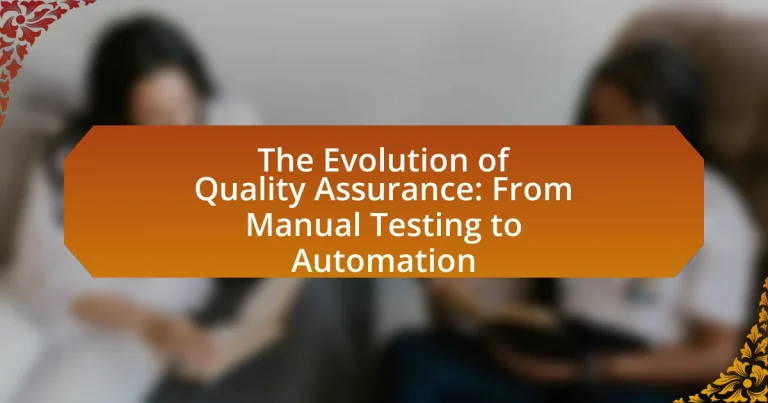The article examines the evolution of Quality Assurance (QA) in software development, highlighting the transition from manual testing to automation. It details the historical milestones that shaped QA practices, including the introduction of automated testing tools in the 1980s and 1990s, the impact of Agile methodologies, and the integration of AI and machine learning in contemporary QA processes. The discussion encompasses the importance of QA in ensuring software quality, the differences between manual and automated testing, and the current trends and future developments in QA automation. Additionally, it addresses the skills necessary for QA professionals and best practices for enhancing QA processes.

What is the Evolution of Quality Assurance?
The evolution of quality assurance (QA) has transitioned from manual testing to automation, significantly enhancing efficiency and accuracy in software development. Initially, QA focused on manual testing processes, where testers executed test cases by hand, identifying defects through trial and error. This approach was time-consuming and prone to human error, leading to the need for more systematic methods.
In the 1980s and 1990s, the introduction of automated testing tools marked a pivotal shift in QA practices. Tools like Selenium and QTP allowed for the automation of repetitive tasks, enabling faster execution of test cases and more reliable results. This transition was driven by the increasing complexity of software systems and the demand for quicker release cycles.
By the 2000s, the adoption of Agile methodologies further propelled the evolution of QA, integrating testing into the development process and emphasizing continuous feedback. This led to the rise of DevOps practices, where QA became an integral part of the software development lifecycle, promoting collaboration between development and operations teams.
Today, QA continues to evolve with advancements in artificial intelligence and machine learning, enabling predictive analytics and smarter test automation. These innovations enhance the ability to identify potential issues before they arise, further improving software quality and user satisfaction.
How has Quality Assurance changed over the years?
Quality Assurance has evolved significantly from manual testing to automation, enhancing efficiency and accuracy in software development. Initially, Quality Assurance relied heavily on manual testing processes, which were time-consuming and prone to human error. As technology advanced, the introduction of automated testing tools allowed for faster execution of tests, increased test coverage, and more reliable results. For instance, the adoption of frameworks like Selenium and JUnit has enabled teams to automate repetitive tasks, reducing the time required for regression testing. This shift towards automation has been supported by the growing complexity of software applications and the need for continuous integration and delivery practices, which demand rapid feedback loops. Consequently, the role of Quality Assurance has transformed from a gatekeeping function to an integral part of the development lifecycle, emphasizing collaboration and proactive quality management.
What were the key milestones in the history of Quality Assurance?
The key milestones in the history of Quality Assurance include the introduction of statistical quality control in the 1920s, the establishment of the Total Quality Management (TQM) movement in the 1980s, and the shift towards automation in the 2000s. Statistical quality control, pioneered by Walter Shewhart, laid the groundwork for measuring and improving quality through data analysis. The TQM movement, popularized by figures like W. Edwards Deming, emphasized continuous improvement and customer satisfaction as central to quality practices. The transition to automation in the 2000s marked a significant evolution, enabling faster testing processes and more efficient quality management through tools and software, reflecting the industry’s adaptation to technological advancements.
How did the introduction of technology influence Quality Assurance?
The introduction of technology significantly transformed Quality Assurance by enabling automation, which increased efficiency and accuracy in testing processes. Automation tools, such as Selenium and JUnit, allow for repetitive tasks to be executed quickly and consistently, reducing human error and freeing up resources for more complex testing scenarios. According to a report by the World Quality Report 2020-21, organizations that adopted automation in their QA processes reported a 30% reduction in testing time and a 25% increase in defect detection rates. This shift from manual testing to automated solutions has led to faster release cycles and improved product quality, demonstrating the profound impact of technology on Quality Assurance practices.
Why is Quality Assurance important in software development?
Quality Assurance is important in software development because it ensures that the software meets specified requirements and functions correctly, thereby reducing the risk of defects. By implementing Quality Assurance processes, organizations can identify and resolve issues early in the development cycle, which leads to improved product quality and customer satisfaction. Studies show that effective Quality Assurance can reduce development costs by up to 30% by preventing defects before they reach production. Additionally, according to the National Institute of Standards and Technology, the cost of fixing a defect after release can be up to 100 times higher than addressing it during the development phase. This highlights the critical role Quality Assurance plays in maintaining software reliability and performance.
What role does Quality Assurance play in ensuring software quality?
Quality Assurance (QA) plays a critical role in ensuring software quality by systematically evaluating and improving the software development process. QA involves various methodologies, including manual testing and automated testing, to identify defects and ensure that the software meets specified requirements. According to a study by the National Institute of Standards and Technology, poor software quality can lead to significant financial losses, estimated at $59.5 billion annually in the U.S. alone, highlighting the importance of QA in mitigating risks and enhancing product reliability. By implementing QA practices, organizations can achieve higher customer satisfaction and reduce the cost of fixing defects post-release.
How does Quality Assurance impact user satisfaction and business success?
Quality Assurance (QA) significantly enhances user satisfaction and drives business success by ensuring that products meet established standards of quality and performance. When QA processes are effectively implemented, they lead to fewer defects and a more reliable user experience, which directly correlates with higher customer satisfaction rates. For instance, a study by the American Society for Quality found that organizations with robust QA practices experience a 20-30% increase in customer satisfaction scores. Additionally, effective QA reduces costs associated with post-release defects, thereby improving profitability and overall business performance. This relationship between QA, user satisfaction, and business success is further supported by data indicating that companies with strong QA frameworks can achieve up to 50% faster time-to-market, allowing them to capitalize on market opportunities more effectively.

What are the differences between Manual Testing and Automation?
Manual testing involves human testers executing test cases without the use of automation tools, while automation testing utilizes software tools to execute tests automatically. Manual testing is often more flexible and can adapt to changes quickly, making it suitable for exploratory and usability testing. In contrast, automation testing is more efficient for repetitive tasks and regression testing, as it can run tests faster and more consistently than humans. According to a study by the International Journal of Advanced Research in Computer Science and Software Engineering, automation can reduce testing time by up to 70%, highlighting its effectiveness in large-scale projects.
What is Manual Testing and how does it work?
Manual testing is a software testing process where testers execute test cases without the use of automation tools. In this process, testers manually check the functionality, usability, and overall performance of the software by following predefined test cases and reporting any defects or issues encountered. Manual testing works by simulating user behavior to ensure that the application behaves as expected under various conditions. This approach is essential for identifying user interface issues, usability concerns, and other defects that automated tests may overlook. The effectiveness of manual testing is supported by its ability to provide immediate feedback and insights into the user experience, making it a critical component of the software development lifecycle.
What are the advantages and disadvantages of Manual Testing?
Manual testing offers several advantages and disadvantages. The primary advantage is its ability to identify user experience issues and usability flaws that automated tests may overlook, as human testers can provide insights based on real-world usage. Additionally, manual testing is flexible and allows for exploratory testing, enabling testers to adapt their approach based on immediate findings. However, the main disadvantage is that it is time-consuming and prone to human error, which can lead to inconsistent results. According to a study by the International Journal of Software Engineering and Its Applications, manual testing can take up to 40% more time than automated testing for large projects, highlighting its inefficiency in scalability.
In what scenarios is Manual Testing most effective?
Manual Testing is most effective in scenarios requiring human judgment, exploratory testing, and user experience evaluation. In situations where software applications have complex user interfaces or require subjective assessment, manual testing allows testers to leverage their intuition and experience. For example, during the early stages of development or when new features are introduced, manual testing can identify usability issues that automated tests may overlook. Additionally, in projects with frequent changes or limited budgets, manual testing provides flexibility and immediate feedback, ensuring that critical issues are addressed promptly.
What is Automation Testing and how does it function?
Automation testing is a software testing technique that uses automated tools to execute test cases, compare actual outcomes with predicted outcomes, and report results. This process functions by employing scripts and software applications to perform tests on the software, which can include unit tests, integration tests, and functional tests, among others.
The automation framework typically consists of test scripts written in programming languages, which interact with the application under test. These scripts can be executed repeatedly, allowing for consistent testing across different versions of the software. Automation testing enhances efficiency by reducing the time and effort required for repetitive testing tasks, thereby increasing test coverage and accuracy.
According to a study by the International Journal of Advanced Research in Computer Science and Software Engineering, automation testing can reduce testing time by up to 70%, demonstrating its effectiveness in improving the quality assurance process.
What tools are commonly used in Automation Testing?
Commonly used tools in Automation Testing include Selenium, JUnit, TestNG, Appium, and Cucumber. Selenium is widely recognized for web application testing, while JUnit and TestNG are popular for unit testing in Java applications. Appium is favored for mobile application testing across platforms, and Cucumber supports behavior-driven development by allowing tests to be written in plain language. These tools are integral to enhancing testing efficiency and accuracy in the automation process.
How does Automation Testing improve efficiency and accuracy?
Automation Testing improves efficiency and accuracy by enabling faster execution of test cases and reducing human error. Automated tests can run continuously and simultaneously across multiple environments, significantly decreasing the time required for testing cycles. For instance, a study by the International Journal of Advanced Computer Science and Applications found that automation can reduce testing time by up to 90%, allowing teams to focus on more complex tasks. Additionally, automated testing ensures consistent execution of tests, which minimizes the risk of discrepancies that can occur with manual testing, thus enhancing overall accuracy.

What are the current trends in Quality Assurance Automation?
Current trends in Quality Assurance Automation include the increasing adoption of AI and machine learning for predictive analytics, the integration of continuous testing within DevOps practices, and the rise of test automation frameworks that support multiple programming languages. AI and machine learning enhance testing efficiency by identifying patterns and predicting potential defects, as evidenced by a report from Capgemini which states that 69% of organizations are using AI in their testing processes. Continuous testing, as part of DevOps, allows for faster feedback loops and improved collaboration, with 63% of organizations reporting enhanced quality through this integration according to the World Quality Report 2021-2022. Additionally, frameworks like Selenium and Cypress are gaining popularity for their versatility and ease of use, enabling teams to automate tests across various platforms effectively.
How is Artificial Intelligence shaping Quality Assurance Automation?
Artificial Intelligence is significantly shaping Quality Assurance Automation by enhancing testing efficiency and accuracy through intelligent algorithms and machine learning techniques. AI-driven tools can analyze vast amounts of data to identify patterns and predict potential defects, thereby reducing the time required for manual testing processes. For instance, according to a report by Capgemini, organizations that implement AI in their testing processes can achieve up to 30% faster testing cycles and a 50% reduction in testing costs. This integration allows for continuous testing and real-time feedback, which are crucial for agile development environments.
What are the benefits of integrating AI into Quality Assurance processes?
Integrating AI into Quality Assurance processes enhances efficiency, accuracy, and speed of testing. AI algorithms can analyze vast amounts of data quickly, identifying patterns and anomalies that human testers might overlook. For instance, a study by Capgemini found that organizations using AI in testing reported a 30% reduction in testing time and a 25% increase in defect detection rates. This integration allows for continuous testing and real-time feedback, significantly improving the overall quality of software products.
What challenges does AI present in Quality Assurance Automation?
AI presents several challenges in Quality Assurance Automation, primarily including the complexity of integrating AI systems, the need for extensive training data, and the difficulty in ensuring consistent accuracy. Integrating AI into existing QA processes can be complicated due to varying software architectures and the need for specialized skills. Additionally, AI models require large amounts of high-quality training data to function effectively, which can be difficult to obtain and manage. Furthermore, maintaining consistent accuracy in AI-driven testing is challenging, as AI systems can produce unpredictable results due to their reliance on algorithms that may not always generalize well across different scenarios. These challenges highlight the need for careful planning and resource allocation when implementing AI in QA automation.
What best practices should be followed in Quality Assurance Automation?
Best practices in Quality Assurance Automation include developing a clear automation strategy, selecting the right tools, maintaining test scripts, and ensuring continuous integration. A clear automation strategy aligns testing efforts with project goals, which enhances efficiency and effectiveness. Choosing the right tools, such as Selenium or TestComplete, is crucial for compatibility with the application and team expertise. Regular maintenance of test scripts prevents obsolescence and ensures they remain relevant as the application evolves. Implementing continuous integration allows for automated testing to occur frequently, which helps identify defects early in the development cycle, ultimately improving software quality. These practices are supported by industry standards and case studies demonstrating their effectiveness in enhancing automation outcomes.
How can teams effectively transition from Manual Testing to Automation?
Teams can effectively transition from Manual Testing to Automation by adopting a structured approach that includes assessing current testing processes, selecting appropriate automation tools, and training team members. First, teams should evaluate their existing manual testing practices to identify repetitive tasks that are suitable for automation. This assessment helps prioritize which tests to automate based on factors such as frequency of execution and criticality to the application.
Next, selecting the right automation tools is crucial; teams should consider factors like compatibility with existing systems, ease of use, and community support. Popular tools such as Selenium and TestComplete have proven effective in various environments, as evidenced by their widespread adoption in the industry.
Finally, training team members on automation frameworks and best practices is essential for successful implementation. Research indicates that organizations that invest in training see a 30% increase in productivity and a reduction in testing time by up to 50%. By following these steps, teams can ensure a smooth transition from manual to automated testing, enhancing overall efficiency and product quality.
What common pitfalls should be avoided in Automation Testing?
Common pitfalls to avoid in automation testing include inadequate test planning, lack of skilled resources, and over-reliance on automation. Inadequate test planning can lead to incomplete test coverage, resulting in undetected defects. Lack of skilled resources may cause poorly designed test scripts, which can lead to false positives or negatives. Over-reliance on automation can result in neglecting manual testing, which is essential for exploratory testing and understanding user experience. These pitfalls can significantly undermine the effectiveness of automation testing, as evidenced by industry reports indicating that 30-50% of automation projects fail due to these issues.
What future developments can we expect in Quality Assurance?
Future developments in Quality Assurance will focus on increased automation, integration of artificial intelligence, and enhanced testing methodologies. Automation will streamline repetitive tasks, allowing teams to focus on more complex testing scenarios. AI will enable predictive analytics, improving defect detection and reducing time-to-market. Enhanced methodologies, such as shift-left testing, will promote early testing in the development cycle, leading to higher quality products. According to a report by Gartner, by 2025, 70% of testing will be automated, underscoring the shift towards these advancements in Quality Assurance.
How might emerging technologies influence the future of Quality Assurance?
Emerging technologies will significantly enhance the future of Quality Assurance by automating testing processes and improving accuracy. Technologies such as artificial intelligence and machine learning can analyze vast amounts of data to identify patterns and predict potential defects, thereby reducing the time and effort required for manual testing. For instance, AI-driven tools can execute regression tests more efficiently than human testers, leading to faster release cycles. Additionally, the integration of automation frameworks allows for continuous testing, which aligns with agile development practices, ensuring that quality is maintained throughout the software development lifecycle. This shift not only increases productivity but also minimizes human error, resulting in higher quality products.
What skills will be essential for Quality Assurance professionals moving forward?
Essential skills for Quality Assurance professionals moving forward include proficiency in automation testing, knowledge of programming languages, and expertise in continuous integration and continuous deployment (CI/CD) practices. As the industry shifts from manual testing to automation, professionals must be adept at using automation tools like Selenium and JUnit, which are critical for efficient testing processes. Additionally, understanding programming languages such as Python or Java enhances the ability to write automated test scripts, thereby increasing productivity and accuracy. Familiarity with CI/CD pipelines is also vital, as it allows QA professionals to integrate testing seamlessly into the software development lifecycle, ensuring faster delivery of high-quality software.
What practical tips can enhance Quality Assurance processes?
Implementing automated testing tools significantly enhances Quality Assurance processes by increasing efficiency and accuracy. Automation reduces human error and allows for faster execution of test cases, enabling teams to focus on more complex testing scenarios. According to a study by the International Software Testing Qualifications Board, organizations that adopted automation reported a 30% reduction in testing time and a 25% increase in defect detection rates. Additionally, incorporating continuous integration and continuous deployment (CI/CD) practices streamlines the testing process, ensuring that code changes are automatically tested and deployed, which further improves product quality.
How can teams ensure continuous improvement in Quality Assurance practices?
Teams can ensure continuous improvement in Quality Assurance practices by implementing regular feedback loops and adopting agile methodologies. Regular feedback loops, such as retrospectives and peer reviews, allow teams to identify areas for improvement and adjust their processes accordingly. Agile methodologies, which emphasize iterative development and flexibility, facilitate ongoing enhancements in testing practices. Research shows that organizations using agile practices report a 30% increase in productivity and a 25% reduction in defects, demonstrating the effectiveness of these approaches in fostering continuous improvement in Quality Assurance.
What resources are available for staying updated on Quality Assurance trends?
To stay updated on Quality Assurance trends, professionals can utilize industry-specific websites, online forums, and social media platforms. Websites like the International Software Testing Qualifications Board (ISTQB) and the Association for Software Testing (AST) provide valuable resources, including articles, webinars, and certification information. Online forums such as Stack Overflow and Reddit’s QA community facilitate discussions and knowledge sharing among practitioners. Additionally, following influential figures and organizations on platforms like LinkedIn and Twitter can provide real-time updates on emerging trends and best practices in Quality Assurance. These resources collectively offer a comprehensive approach to staying informed in the rapidly evolving field of Quality Assurance.


